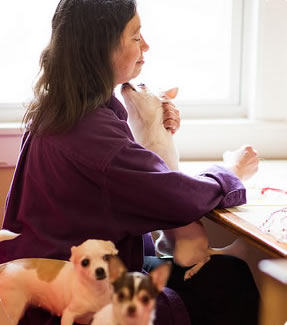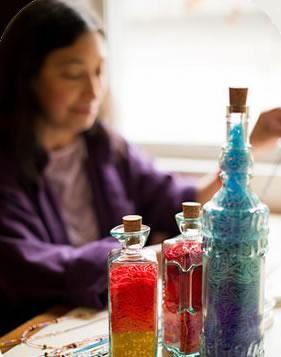Life Traditions
One Native American Gives Back

Learn how you can make something positive from your cancer diagnosis: Turning it Around
Photo by Edda Pacifico
Shoshana Phillips has spent most of her 51 years engrained in Omaha Nation culture with the goal to educate and help her Native American tribe flourish. She traveled by car with her husband and two children to attend powwows -- gatherings with music, food and dance -- to help wherever needed: with environmental issues, religious freedom issues or even making beaded jewelry and powwow regalia for kids.
It was only when she was diagnosed with multiple myeloma six years ago she realized the disparities among Native Americans with cancer, including children whose parents have cancer.
"My diagnosis made me aware of a need to fill,"” she says. "We realized cancer is something that affects the whole family, yet there are virtually no services for kids. A 20-year study showed that Native Americans were the only segment of the U.S. population where cancer deaths did not decrease over that time period.
For members of the Omaha Nation, Phillips says, there are four stages of life represented by four colors that coincide with the four directions on a compass.
"East represents infancy, which is yellow," she says. "South is for childhood and the color green. West direction is the time of adulthood and the color red. The north side is elderhood, represented by the color black."
Phillips' daughter, Alethea, whose Omaha name means "girl with reddish brown hair" told her mom they should try to help Native American kids in a worse position than she was. Together they worked to form a non-profit organization intended to help children in need now and to educate young people to make healthy lifestyle choices to avoid obesity, diabetes and cancer in the future.
Adult infusion nurse Colleen Dauw, R.N., says it's not uncommon to see patients with cancer trying to give back.
"Shoshana has been helping people in her tribe her whole life," says Dauw. "It puts a very positive light on healing and working to become well. It doesn't surprise me that her daughter is following in her footsteps to want to make a difference in the Native American community."
Still undergoing treatment for her cancer, Phillips recently secured an Ypsilanti house to be the home for her non-profit, Heritage of Healing. Her goal is to give her own family a safe and healthy living environment, as well as having dedicated space to take in Native Americans and their families when they're in Ann Arbor for treatment.
"On the reservations, there is no treatment for cancer. They have to send you somewhere else. We would like to be there in support of people being treated off the reservation. We'll provide housing and work with Food Gatherers to offer meals. Eventually, we'd like to be able to provide rides to treatment and gift cards for things like gas and groceries."

Cancer incidences among American Indians vary by tribe, region and gender, but are often much higher than non-Hispanic whites. Many factors contribute, including a high burden of risk factors like tobacco and alcohol abuse, poor diets due to commodity items like white flour and white sugar, low awareness of cancer risks and screening options, high rates of poverty and poor access to health care due to low rates of health insurance.
American Indian and Alaska Native populations have very high incidence rates for specific cancer sites and poor survival rates for most cancers. According to the American Indian Cancer Foundation, cancer has recently become the No. 1 cause of death for American Indians in many regions of the United States.
In Phillips' case, the doctors she initially saw were unable to piece together any of her symptoms, which included fatigue, a painful bump on her knee and unusual pain when her then-toddler son hit her in the back. Phillips pressed on with her family for four years before being misdiagnosed in Arizona with fibromyalgia, a chronic pain syndrome. When she came to the University of Michigan for a research study, she received her real diagnosis: multiple myeloma, a cancer of the plasma cells in bone marrow.
Phillips ended up in a different research study altogether and had her first round of chemo while still admitted in the hospital from her emergency room visit. A clinical trial for the drug Velcade had just opened 10 additional spots for participants. Since then she has undergone two bone marrow transplants.
"I've definitely beaten the odds for multiple myeloma, which has less than a 35 percent survival rate for more than five years," says Phillips. "My diagnosis has definitely opened up a new path for me. I think all people have something they're meant to do. The time I have now is more time to be with my kids, and to establish this legacy they can carry on in the future to help other Native Americans with cancer."
Now 13, Phillips' daughter Alethea is living up to the color red through a very grown-up life of advocacy. She's planned a summer camp for Native American kids and hopes to make it a reality this summer.
Turning it Around
Here's how:
Be creative
Many patients turn to art as an outlet, not only for their own benefit, but to let others know things get better.
Donate
Give money to organizations that support cancer patients (including the U-M Rogel Cancer Center!)
Volunteer
Some cancer survivors choose to volunteer at meetings or other community events for people dealing with a cancer diagnosis.
Advocate
Who better than cancer survivors to lobby for more treatment options, better patient care and more research funding?
Contribute to change
Represent patients by joining the Rogel Cancer Center's Patient and Family Advisory Committee
Read the Spring, 2013 issue of Thrive.
